Where Did Star Trek Get Live Long and Prosper
Multiple realities
(covers information from several alternate timelines)
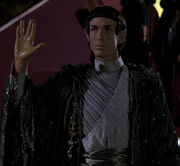
A Vulcan salute ( Star Trek: First Contact )
The Vulcan salute was a hand gesture used by Vulcans. It involved holding the palm of one hand outwards while placing the fingers in a "V" shaped by separating the middle and ring fingers, while keeping the others together, with the thumb extended.
Contents
- 1 Usage
- 2 Appendices
- 2.1 Appearances
- 2.2 Background information
- 2.2.1 Origins
- 2.2.2 Serialization
- 2.2.3 Influence and other usage
- 2.3 External links
Usage
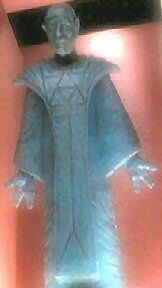
A statuette of Surak performing a version of the Vulcan salute
The salute was part of both Vulcan greetings and farewells. The formal phrase associated with the salute in both cases was "Live long and prosper." ( Star Trek: First Contact ; TOS: "Amok Time")
When parties took their leave of each other, one party could use the phrase "Peace and long life" and would receive "Live long and prosper" as a reply. (TOS: "Is There in Truth No Beauty?", "The Savage Curtain"; Star Trek IV: The Voyage Home ; TNG: "Sarek", "Unification I") Alternately, each party could simply state to the other "Live long and prosper, (name)." (TOS: "Amok Time"; Star Trek: Voyager various episodes)
In the Vulcan language, "Live long and prosper" was pronounced "Dif-tor heh smusma." ( Star Trek: The Motion Picture )
In diplomatic situations, the greeting used was "I/We (depending on situation) come to serve," possibly prefaced by the statement of the initiators' name. The response was "Your service honors us." (TOS: "Journey to Babel"; TNG: "Data's Day", "Sarek", "Unification I")
In 2151, a statuette of Surak performing the Vulcan salute with both hands was displayed aboard the Vahklas, a Vulcan ship. Unlike other Vulcan salutes, Surak's hands were not held upright. (ENT: "Fusion")
In February 2152, Vulcan Ambassador V'Lar wished Sub-Commander T'Pol goodbye with the phrase "Live long and prosper." T'Pol, however, bowed in response. (ENT: "Fallen Hero")
In the final draft script of "Fallen Hero", both Vulcans were described as demonstrating the Vulcan hand salute and saying the farewell that, in the final version of the episode, only V'Lar states.
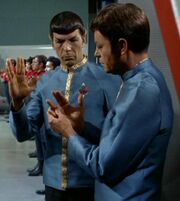
Spock shows McCoy how to do the salute
Several Humans greeted Vulcans with the hand gesture, including Captain Jonathan Archer in 2154 (ENT: "Kir'Shara") and Captain Jean-Luc Picard in 2368. (TNG: "Unification I") T'Pol taught Trip Tucker the salute when she took him to Vulcan to meet her mother, T'Les. (ENT: "Home") Zefram Cochrane tried and failed to perform it in 2063, during First Contact; he settled on a handshake instead. ( Star Trek: First Contact ) Michael Burnham learned the salute from her brother, Spock, as a child. (DIS: "Perpetual Infinity") When Leonard McCoy attempted to perform the salute, he said it hurt worse than having to wear his dress uniform. (TOS: "Journey to Babel") The saying was quite well-known among those in Starfleet – in 2375, trapped in the Delta Flyer under layers of rock, two minutes before the air would run out, Tuvok told Tom Paris, "In accepting the inevitable, one finds peace," to which Paris responded that, if this was another Vulcan axiom, he would stick to "Live long and prosper." Fortunately, Paris had barely finished the sentence when he was interrupted by the sound of USS Voyager's phaser drills breaking through the rock, and those on board the Delta Flyer were safely beamed back to the ship. (VOY: "Once Upon a Time")
In ultimately omitted dialogue from the final draft script of "Kir'Shara", a puzzled Archer revealed he had "never been able to get [his] fingers" to display a Vulcan salute prior to the one he performs in that installment.
As a practical joke, Tom Paris and Harry Kim once reprogrammed Tuvok's security console so that it said, "Live long and prosper" whenever he accessed the internal sensors. They also reprogrammed his replicator the same way. (VOY: "Revulsion")
Ensigns Beckett Mariner and Bradward Boimler occasionally used the gesture as a sarcastic jest with each other, or with other people. This is done by performing the gesture, then swinging that arm up and down by the elbow.(LD: "Moist Vessel", LD: "Terminal Provocations")

Captain Archer performing a Vulcan salute (ENT: "Kir'Shara")
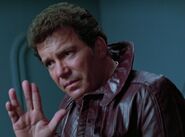
In 2258, in the alternate reality brought about by Nero's incursion, Ambassador Spock, after speaking with a younger version of himself, made the hand gesture but said, "Good luck," as he felt it would be "oddly self-serving" to say the usual phrase to his younger counterpart. ( Star Trek )
In 2263 of the alternate reality, the Vulcan salute was exchanged between the Spock who was indigenous to that universe and a pair of Vulcan messengers who had brought him news that Ambassador Spock was dead. Spock used the salute to bid farewell to the Vulcan pair on Starbase Yorktown, both Spock and his Vulcan visitors saying "Live long and prosper" to each other before the messengers walked away. ( Star Trek Beyond )
In the mirror universe, the first Vulcan to step on Terran soil used the traditional greeting before being shot by Zefram Cochrane, after he failed to duplicate the gesture. (ENT: "In a Mirror, Darkly") Thereafter, in the mirror universe, it was not safe, even behind closed doors, for Vulcans to perform the Vulcan salute, for fear that they might be seen by a Terran. (ENT: "In a Mirror, Darkly, Part II")
Appendices
Appearances
The Vulcan salute is seen in all the in-universe completed Star Trek TV shows except DS9. This list is in order of air date and is labeled as follows: if the salute is only said verbally without the hand gesture, then it is labeled as "only said"; if the hand gesture is only seen without the words, it is labeled as "only gestured"; and if the salute is both said and gestured, then it will appear normally with no label.
- TOS:
- "Amok Time"
- "Journey to Babel" (only gestured)
- "Assignment: Earth" (only said)
- "The Enterprise Incident" (only gestured)
- "Is There in Truth No Beauty?"
- "The Savage Curtain"
- TAS:
- "Yesteryear"
- TNG:
- "Conspiracy" (only gestured)
- "Sarek"
- "Data's Day" (only gestured)
- "Unification I"
- "Unification II"
- VOY:
- "Revulsion"
- "Year of Hell, Part II"
- "In the Flesh"
- "Once Upon a Time" (only said)
- "Counterpoint"
- "Gravity"
- "Riddles" (only said)
- "Live Fast and Prosper"
- "Shattered"
- "Homestead"
- ENT:
- "Fallen Hero" (only said)
- "Home" (only gestured)
- "The Forge"
- "Kir'Shara"
- "In a Mirror, Darkly"
- "In a Mirror, Darkly, Part II" (only gestured)
- DIS:
- "Battle at the Binary Stars"
- "Lethe"
- "The War Without, The War Within" (only gestured)
- "Light and Shadows" (only gestured)
- "If Memory Serves" (only gestured)
- "Such Sweet Sorrow, Part 2" (only gestured)
- "Unification III"
- "Terra Firma, Part 2" (only gestured)
- "Choose to Live"
- ST:
- "Ephraim and Dot"
- LD:
- "Moist Vessel"
- "Terminal Provocations" (only gestured)
- "wej Duj"
- Star Trek films:
- Star Trek: The Motion Picture
- Star Trek II: The Wrath of Khan
- Star Trek III: The Search for Spock
- Star Trek IV: The Voyage Home
- Star Trek V: The Final Frontier (only gestured)
- Star Trek: First Contact
- Star Trek
- Star Trek Into Darkness (only gestured)
- Star Trek Beyond
Background information
Origins
The Vulcan salute was devised by Leonard Nimoy, based on a gesture made by various Jewish denominations, including Orthodox and Conservative. In TV Land's The 100 Greatest TV Quotes & Catchphrases, William Shatner described the salute as a benediction, comparing it to the Sign of the Cross. The gesture actually forms the Hebrew letter "Shin" and represents the honorific title "Shaddai", which means "Almighty (God)." The hand gesture is traditionally used by the Kohanim (Hebrew "priests"), Jews of priestly descent, during a blessing ceremony performed during the prayer service of certain Jewish holy days. The Jewish blessing is done with both hands, with arms extended upward at roughly a forty-five-degree angle, rather than one hand held upright as in the Vulcan salute. Nimoy learned the gesture, which takes practice to do, from visiting his grandfather's synagogue as a child. In the video William Shatner and Leonard Nimoy: The Twenty-Five Year Mission , Nimoy stated, "It took me years of diligent practice and self-denial to be able to do that." [1]
The Vulcan salute wasn't originally in the script of "Amok Time", which called for Spock to walk up to T'Pau followed by them simply exchanging brief greetings. Leonard Nimoy thought this might be a good chance to bring something unique to the Vulcan people. When he spoke to the episode's director, Nimoy suggested – citing examples of other gestures conveying greetings, such as handshakes, salutes, and bows – that perhaps Vulcans would greet each other with the Jewish gesture he remembered from his childhood, and the director agreed to try it. However, the actress playing T'Pau, Celia Lovsky, initially couldn't perform the salute, presenting a problem for the production personnel. They solved it by using a simple camera trick where her hands were below camera frame while she used one of her hands to get the other hand in the proper position. The salute was established from then on. According to an interview with Leonard Nimoy, the line "live long and prosper" was written by Theodore Sturgeon (the author of "Amok Time"). [2]
Serialization
William Shatner was unable to do the Vulcan salute. When Kirk (as played by Shatner) performs the salute in Star Trek III: The Search for Spock , it appears that fishing line holds two of his fingers together. In the video William Shatner and Leonard Nimoy: The Twenty-Five Year Mission, Shatner joked that the reason he couldn't do it was because, in Leonard Nimoy's words, it took "years of diligent practice and self-denial." During a June 2009 appearance on The Tonight Show with Conan O'Brien, Shatner demonstrated his inability to perform the salute, to which O'Brien responded with a perfect salute of his own.
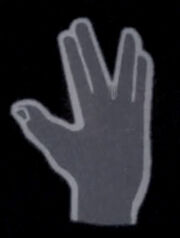
A sign of the M-9 language
As an in-joke, one of the gestures of the M-9 sign language is similar to the Vulcan salute. (Star Trek Encyclopedia)
The first Vulcan to fail to perform the salute on screen was Sarek in TNG: "Unification I", being terminally ill.
In the writers' second draft script of ENT: "Breaking the Ice", Sub-Commander T'Pol and Captain Vanik exchanged Vulcan salutes, unaccompanied by any of the traditional Vulcan greetings. However, they don't exchange the salute (and their initial meeting is not shown) in the final version of that episode.
In the script of the 2009 film Star Trek , the Vulcan salute was described as "legendary". [3]
Influence and other usage
Armin Shimerman devised a Ferengi gesture inspired by the Vulcan hand salute. "I know that the Vulcan hand sign is universally recognized," he commented. "I thought, 'Let's see if we can find something like that to do.'" (Star Trek: Deep Space Nine Companion (p. 647))
Molly Hagan developed a Vorta greeting for Eris that was ultimately not used. She commented: "I immediately began working on a physical gesture that would indicate when I was using my telekinesis. I thought it could become the defining gesture of my people, like the Vulcan 'Live Long and proper' hand gesture. So, I came up with a motion where both my hands looked like they were taking energy in from my body before I pulsed it back out through my hands. It reminded me of something I saw Bruce Lee do. It never got used because a) they had great special effects and didn't need me to do any gestures to sell 'my powers' and b) they were concerned that any future Vorta may not be able to replicate it. I was beyond disappointed." [4]
The Filipino greeting "Mabuhay" can also be roughly translated as "live long and prosper" (it literally means "Live", but the expression is meant to convey a wish for someone to have a long and prosperous life in order to truly "live"). [5]
In Act 5, Scene 3, line 42, of Shakespeare's Romeo and Juliet, Romeo says to Balthasar, "Live, and be prosperous, and farwell good fellow." [6]
It was proposed, accepted, and published in Version 7 of the Unicode Standard as Unicode Character U+1F596 (🖖 "RAISED HAND WITH PART BETWEEN MIDDLE AND RING FINGERS"). [7] [8]
A physician addressed a closed-door meeting of the US House Democratic caucus on 10 March 2020 where he "lightheartedly suggested" that people could employ the "live long and prosper sign" as a way to forgo handshakes and other physical forms of greeting during the outbreak of COVID-19. [9] [10]
External links
- Vulcan salute at Wikipedia
- The Jewish Origin of the Vulcan salute - a page by Rabbi Yonassan Gershom, with photos and diagrams of how the salute forms the Hebrew letter Shin, the use of the Blessing Hands gesture on Jewish gravestones and jewelry, etc.
- Names of God in Judaism at Wikipedia shows a clear illustration of the Judaic origin of the Vulcan salute
Where Did Star Trek Get Live Long and Prosper
Source: https://memory-alpha.fandom.com/wiki/Vulcan_salute
0 Response to "Where Did Star Trek Get Live Long and Prosper"
Post a Comment